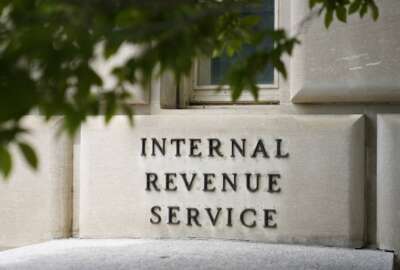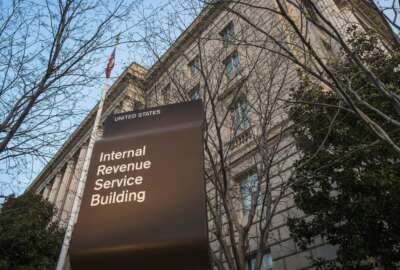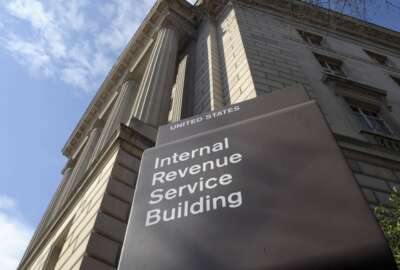IRS underestimated cost of letting people file for free
The IRS’ direct file program was created to make things easier on taxpayers. Direct file, as its called, helps certain taxpayers file their tax returns for...
The IRS’ direct file program was created to make things easier on taxpayers. Direct file, as its called, helps certain taxpayers file their tax returns for free, utilizing the the IRS website. IRS is running a pilot program this filing season and may have been a bit off when estimating how much the program will cost. That’s the finding of the government accountability office (GAO). Federal News Network’s Eric White got more from the GAO’s Director of Strategic Issues, Jay McTigue on the Federal Drive with Tom Temin.
Interview Transcript:
Eric White So why don’t we just start from the beginning and, yeah, lay out how the direct file tax system would work for those of our listeners who aren’t familiar with it. It’s, you know, not quite out in the open yet as IRS is still trying it out.
Jay McTigue Right. So Direct File is a new IRS system for preparing and filing a tax return online for free. As you said, IRS is piloting the system now during the 2024 tax filing system or season, someone interested in using direct file would simply go to irs.gov and log in to direct file. Then the taxpayer answers interview style questions to prepare and electronically submit their tax return to IRS without the help or cost of a third party. The pilot is currently open to taxpayers with simple tax situations residing in 12 states, and an example of a simple tax situation is a taxpayer with wage income taking the standard deduction and may be claiming the child tax credit or the earned income Tax credit. IRS has been working with the US Digital Services, taxpayers, state revenue offices and others on this project. And Eric, I’d like to note that we, in addition to the report that we just issued, we’re continuing to assess the operation of the pilot and options for direct file going forward. And so, we’ll be issuing another report later this year.
Eric White Gotcha. And you know, I don’t know I don’t know if it’s quite come to fruition yet, but what would the IRS be doing with the program. Would they be overseeing making sure that, you know, that all the boxes are checked, and all the eyes are dotted on that after a taxpayer files it through this program?
Jay McTigue Yes. You know, there are basic quality control checks built into the system. And IRS has noted that it hopes that taxpayers maybe it may make it easier for taxpayers to claim certain tax benefits, especially deductions, you know, that they’re eligible or that they might not otherwise be aware of.
Eric White All right. So, let’s get down to brass tacks. How much does the agency say the program will cost. And after you’re looking into it, is that an accurate assessment coming from you all.
Jay McTigue Right. So, in May of last year, IRS reported to Congress that the annual cost of a direct file system could range between $64 million to up to 240 million, depending upon the number of taxpayers served and the complexity of tax situations supported by the system. As of the end of this January, IRS reported that approximately 9.4 million had been spent on the program. As for how accurate the estimate is, we did identify opportunities for improvement. And, you know, IRS did follow some best practices for good cost estimation. For example, the agency did describe assumptions used to calculate their estimate. And they also analyzed how the costs might change of certain assumptions, like the number of taxpayers using the system, you know, changed. However, IRS did not include some important costs, such as start-up costs, which could be substantial in a new system like this. And furthermore, the estimate was not documented.
Eric White And yeah, when you say start-up costs and, you know, getting the infrastructure in place to make sure the system is running well, you know, when it eventually, I imagine, expands, what does that mean? And, you know, just how much money are we talking about there?
Jay McTigue Sure. That’s the million-dollar question, Eric. And, IRS told us that the US Digital Services, which is part of the Office of Management and Budget and the Executive Office of the president, actually developed a prototype that evolved into the direct file system. And because IRS is not required to reimburse USDS for its employees, IRS reported no costs for the prototype. Currently, IRS is using about 29 employees from the US Digital Services to supplement their own staff, and IRS could not provide any additional information on, you know, the extent of USDS resources used for direct file. IRS did note in their report to Congress last year that while technology investments could be substantial, a lot of the running cost or the operating costs would actually be for customer service. And, you know, that’s why we think as we. Indicated in the report that the pilot that IRS is currently conducting really is an opportunity for IRS to collect additional data which could help improve their cost estimates going forward. And, you know, some examples of what kind of data that we’re talking about is, you know, how much time does it take employees to help taxpayers as they navigate, you know, direct file? And then on the technology side that we were talking about, IRS has been testing data transfer capabilities that would allow data from the federal return to populate state filing systems. And, you know, to the extent that you know, that system or that capability could be expanded, obviously there could be additional costs associated with that. And so, these types of data, you know, would help inform a more robust cost estimate for the program.
Eric White Kind of ironic coming from an agency that gives you guff every time you overestimate or underestimate the value of something. We’re speaking with James McTigue of the Government Accountability Office. So, what’s at stake here if the IRS doesn’t have a proper cost assessment before they head into, you know, full implementation? I imagine, you know, we’re probably very, very far off from that. But it is probably a good idea to keep in mind of just how much this is going to cost the agency, since dollars aren’t easy to get from Congress, especially for the IRS.
Jay McTigue Oh, that’s a great point. And you know, for any program or any agency, an accurate cost estimate is very important. You know, good cost estimates support good decisions about funding one program over another or to evaluate the resources. A key decision points as to, you know, in this case, whether to expand the program, terminate the program, you know, support different tax situations and other key questions like that. And then finally, you know, cost is a very important performance measurement. And, you know, its customer service is another. But, you know, together performance has to be assessed in a holistic manner. You know, quite frankly, having realistic, cost estimates inform how to manage a program and, you know, increases the probability of a, you know, that the program will be successful. And I know, you know, this is a new system, new territory for IRS. And initial cost estimates are going to have all kinds of uncertainties, but a full range of costs, you know, can help inform the decisions that IRS will need to make as it decides whether or not to make the program permanent, or consider additional tax situations that I described.
Eric White Yeah. On that decision. In your review, has the agency said anything about the benefits of this kind of system? Because it seems as if there is an opportunity to save some money there if you’re not having to go after people who, for non-malicious reasons, messed up on their tax returns, you know, if they’re able to just work upfront with the IRS at first, is there a benefit there and is that what they mean. And saying there is a certain cost benefit to a system such as the one that they’re describing?
Jay McTigue Sure. I agree with what you said. You know, to the extent that IRS can make filing a tax return easier and more straightforward for taxpayers, the more likelihood there is that taxpayer payers will be compliant and pay the taxes, that they owe or get the refund that they deserve. In addition to that, I would add a couple things. You know, there are potential cost savings to both taxpayers and the IRS. And IRS actually put a number on, you know, the potential benefit to taxpayers, you know, based on certain assumptions, IRS estimated that taxpayers potentially could save up to $21 million in money they otherwise would have to pay commercial preparers or tax professionals, as well as the, you know, the value of the their own time spent on the process. And, you as far as IRS, IRS has been trying to reduce the amount of paper that it deals with, and it identified an estimated 200,000 paper filers who may be eligible to participate in the pilot and file their return electronically, which is much easier and efficient for IRS to process.
Copyright © 2025 Federal News Network. All rights reserved. This website is not intended for users located within the European Economic Area.
Eric White is news anchor and Federal Drive producer at Federal News Network.
Follow @FEDERALNEWSCAST






